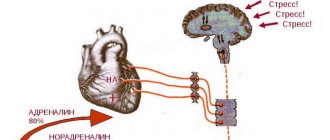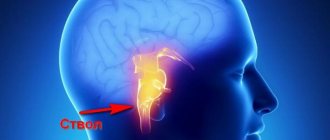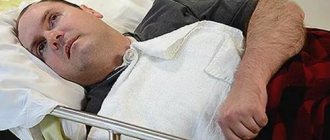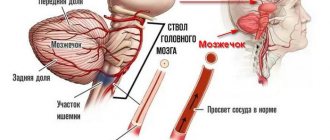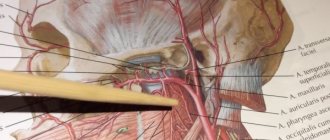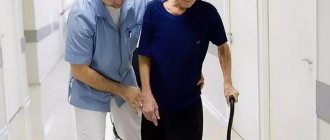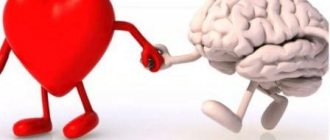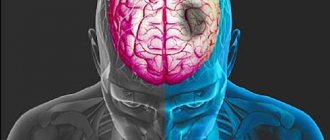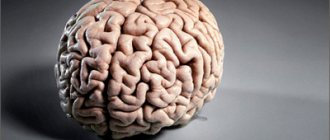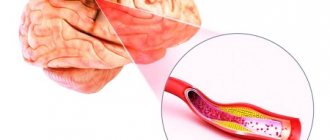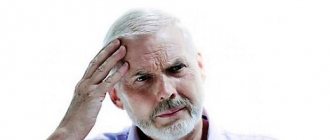Description and features of the disease
Each area of the brain is responsible for performing specific and very important functions. When these zones are damaged, a person loses reflexes, abilities and ceases to control his body.
Important! The more significant the area of brain damage, the brighter the clinical picture, and the less likely it is that the body will be able to regain lost functions.
If, with small ischemic foci, nearby structures take over the functions of the affected areas, then with a significant lesion, this scenario is unlikely, and sometimes not at all possible.
An extensive type of pathology develops due to deterioration or complete cessation of the supply of nutrients to part of the brain , while oxygen starvation of the brain structures is noted. This leads to a number of destructive processes, recovery from which is very difficult.
The illness may be:
- Hemorrhagic - an unfavorable option in which the positive outcome is no more than 10%;
- Ischemic – short-term deterioration in vascular patency, and with immediate treatment the pathological condition is relieved;
- Stem - in this case, not the entire brain is affected, but only its trunk - the base, however, it is in it that the breathing centers are localized, as well as the centers on which the work of the heart depends.
Important! Trunk stroke in almost 100% of cases threatens with a disappointing prognosis - death.
An extensive type of stroke is a general term for massive damage to the blood vessels of the brain; its signs are sharply expressed and manifest themselves in the following:
- cerebral symptoms;
- depressed consciousness;
- focal disorder clinic;
- cerebral edema;
- disturbances of consciousness – hemispheric damage – disorder of speech function, loss of consciousness, lack of adequate assessment of well-being;
- violation of systems management;
- CNS disorders;
- paresis.
As for observation from the outside, a major stroke can be determined by the following clinical picture:
- loud breathing with wheezing;
- increased pulsation of blood vessels;
- displacement of the eyeballs;
- vomit;
- paralysis of limbs;
- involuntary motor reactions of healthy limbs.
Symptoms
There are several stages in the development of the disease. Acute lasts for 21 days. Within this stage, the most acute stage is distinguished, lasting approximately five days and characterized by an increase in the brightness and variety of symptoms.
Next comes the early rehabilitation stage, which lasts up to 5 months. At this time, the blood supply to the remaining cells is restored, and compensation tasks are distributed.
The late recovery stage conventionally lasts from the seventh month to a year. At this stage, the affected tissues become scarred. Cysts and glial formations form at the site of damage.
Attention. A year after the impact, the stage of residual manifestations begins.
Beginning of the disease
Many people imagine that during an attack a person falls due to sudden paralysis and loses consciousness. Indeed, such a beginning is very characteristic of a blow. At the same time, a person does not feel any warning signs.
Sometimes symptoms begin to increase in waves. The patient's condition either worsens or returns to normal. The pathology resembles a microstroke . Patients complain that, for example, their arm has temporarily failed.
Approximately a third of patients with intact memory, who are able to speak and express their thoughts after an attack, describe certain symptoms that anticipated the attack.
For reference. The approach of the disease is indicated by emerging speech disorders - patients do not understand speech addressed to them, cannot express their thoughts, find words, and start talking.
Visual disturbances are noted. Floaters appear before the eyes, parts of the field of vision fall out. Pain occurs.
Motor functions, the ability to sit and turn disappear. Signs of paresis appear. There is a feeling that an arm and leg are paralyzed on one side or both. The patient loses his balance.
The person notices arrhythmia and feels that the pulse disappears. Dizziness appears. Patients often report pain that is described as very severe.
With due attention, others can suspect the development of the disease. Already at the initial stages it is determined which side of the brain is affected during a stroke - the right or the left.
However, they often do not pay enough attention to a sudden speech disorder, the inability of a loved one to utter simple words or answer an easy question. The drooping corner of the mouth on one side and the fact that one of the arms has failed is ignored. Delay in identifying the disease prevents patients from surviving.
Development of the disease
If the warning signs of an attack can be confused with signs of other diseases and attributed to poor health, then the signs of a blow occurring to a person are unlikely to be confused with anything.
If you notice the following symptoms in others, immediately call an ambulance:
- Impaired consciousness. In this case, several degrees are distinguished. With mild and moderate changes, there is stupor, heaviness in the head, lethargy of the patient, fixation of the gaze at one point, and inability to answer questions. With stupor, it is impossible to establish contact with a person; pain and pupillary reflexes remain intact. The most severe disorder is coma. It is almost impossible to survive with this condition.
- Change in breathing. It becomes superficial, weak, sometimes noisy and rapid.
- Inability to move. With a stroke, paresis and paralysis develop.
- Cramps. The whole body is affected by convulsions, muscles tense, and the person is unconscious.
- Distorted face.
- Stiff neck.
Signs of a left-sided injury
Damage to the left side in a stroke leads to muscle weakness on the right side of the body. There is a loss of memory, analysis, and counting. Left-sided stroke is characterized by speech impairments and inability to understand what is heard.
The arm on the right is bent at the elbow, the leg, on the contrary, is extended, the foot is turned inward. Palms clenched into fists.
The emotional background is characterized by dejection and depression. A person is prone to depression, apathy, and isolation. This mood does not increase the chances of improvement.
After a stroke with paralysis on the right side, recovery is more difficult.
Signs of right-sided lesion
Damage to the right hemisphere leads to left-sided hemiparesis. Characterized by a disorder of sensations. A person thinks that he has several legs and arms. Sometimes it seems as if the limbs do not belong to him at all.
Damage to the left hemisphere of the brain
Depending on the side from which the blood flow was interrupted, the symptoms will vary, and the duration of the recovery period and life prognosis also depend on this.
With a left-sided lesion, the following occurs:
- neural conduction on the right side is lost, paresis or paralysis may occur;
- visual perception of the right eye deteriorates;
- speech loses its meaning, becomes incoherent or disappears completely, someone else’s speech ceases to be perceived;
- the patient loses the ability to read and write;
- there is no information analysis;
- a person loses the ability to remember events and numbers;
- performance of everyday activities is disrupted;
- there are mental health problems.
However, despite all of the above, it is somewhat easier for patients with damage to the left hemisphere to recover than those with damage to the right hemisphere.
Recovery
Rehabilitation after a major stroke of the left or right side is a complex, lengthy process. You need to start it immediately after the impact. The rehabilitation process includes several stages:
- Maintaining body functions, preserving life.
- Self-care skills training.
- Restoring the ability to sit, move, and think.
- Return of speech functions and fine motor skills.
For reference. In the first stages of rehabilitation after a major stroke, the use of medications aimed at improving brain function, blood circulation, impulse transmission, activating thinking, and relieving agitation is involved.
Medicines are prescribed to help prevent re-bleeding. Treatment is carried out in courses.
Great importance is given to care. It is aimed at preventing the occurrence of bedsores, the occurrence of infectious diseases, and preventing suicide attempts. Any additional disease should be cured as quickly as possible.
To recover from paresis and paralysis caused by a stroke, therapeutic physical exercises and massage are performed every day. Physiotherapy courses are shown. When deciding how to recover from a stroke on the right side, follow medical recommendations.
For reference. Restoring self-care skills during paralysis begins with the simplest - directing the movement of the arm that has been paralyzed by an assistant and maintaining balance.
In case of right-sided paralysis due to a stroke, the left side is also developed so that there is opportunity for bilateral development and compensation for the function of the damaged side.
If the patient is conscious, he is asked to perform eye movements to restore vision.
Even with complete paralysis after a stroke, attempts are made to restore speech functions. They constantly talk to the person, let them listen to songs and music. If possible, ask to do lip exercises.
Memorization and comparison exercises help restore thinking and memory. If necessary, a speech therapist, physiotherapist, psychiatrist, or rehabilitation specialist are involved in the rehabilitation process.
Right hemisphere damage
In this case, the symptoms will be as follows:
- partial memory loss;
- the patient’s speech is normal, which causes some difficulties with diagnosis;
- left-sided numbness or paralysis;
- facial muscles are affected on the left;
- lethargic and depressed state of mind;
- lack of spatial orientation;
- misunderstanding of human emotions.
The pathology has a very clear clinical picture, so anyone close to the victim can suspect it:
- drooping lips, the face resembles a grin;
- paralysis;
- slurred speech or complete absence of speech;
- coordination disorders;
- increasing cutting headache;
- disturbance or loss of consciousness.
So, after a right-sided massive stroke, a person loses functional manifestations of the left side of the body, lack of response to stimuli on the left arm, leg, and lack of hearing in the left ear.
Hemorrhagic type
Hemorrhagic strokes are classified as follows:
- intracerebral - a hematoma appears in the nervous tissue - in its parenchyma;
- subarachnoid - the vessels of the arachnoid membrane are damaged;
- ventricular - a blood clot is observed in the cerebral aqueduct or in one of its ventricles;
- mixed - combined form.
This type of stroke is damage to the vascular wall , leading to the shedding of blood either into the space between the membranes of the brain, or directly into the tissue of the organ itself.
The disease develops suddenly with a sharp increase in pressure in the arteries. As a result of the shedding of blood, neurons malfunction and die; even a small amount of blood can lead to life-threatening disorders.
This stroke occurs when:
- artery rupture, arterial hypertension;
- rupture of aneurysms located inside the intracranial space;
- breakthrough of microangiomas;
- vein thrombosis;
- inflammation of blood vessels of an infectious nature.
We invite you to watch a useful video on the topic:
Mechanism of development of major stroke
The development of ischemic and hemorrhagic stroke occurs differently. The difference stems from differences in the mechanism of what occurs during a major stroke.
Mechanism of development of ischemic stroke
The pathogenesis is centered on the formation of an area of dead brain tissue, around which edema forms.
For reference. It takes several minutes for irreversible consequences to occur in the area where the blood flow rate has decreased significantly (less than 10 ml / 100 g per minute). This area is usually called the core or core of ischemia.
For several hours after the impact, the core is surrounded by still living tissue. However, she had already begun to experience lack of nutrition. The speed of cerebral blood flow in such lesions does not exceed 20 ml/100 g per 1 minute. This zone is called the penumbra or ischemic penumbra. Due to a deficiency of nutrients in its cells, metabolic processes are disrupted, which leads to loss of function.
Penumbra tissue is very sensitive to any pressure disturbances. Incorrect action, lifting, incorrectly selected therapy after an attack increase the infarction area. It is this area that becomes the target for urgent treatment.
In parallel with the processes occurring in the brain tissue, edema develops; in severe cases, it covers the entire hemisphere. Metabolic processes are disrupted and the blood-encephalitis barrier is destroyed.
The severity of the disease depends on the size of the affected area, the damaged vessel, concomitant diseases, and the time of initiation of treatment.
Mechanism of development of hemorrhagic stroke
For reference. Brain hemorrhage occurs when the vascular walls are destroyed due to a decrease in their elasticity and strength. The gap can be quite large.
The leaking blood permeates the surrounding brain tissue and leads to the formation of a hematoma. It puts pressure on surrounding cells, contributing to their destruction and irritation. In parallel, intoxication of cerebral tissues occurs with decay products.
It is noted that hematomas put pressure on other tissues of the central nervous system, causing their displacement and deformation due to the clearly limited space of the cranium.
Ischemic type
Blood stops flowing to certain parts of the brain, as a result of which their nutrition stops, and tissue destruction and necrosis occurs. Cerebral ischemia can be caused by:
- vascular pathologies accompanied by thickening of the vessel wall;
- a blood clot that blocked the blood flow;
- large plaques in the vessels.
This type of stroke is preceded by a so-called transient ischemic attack ; it can last several hours. In the case of a prolonged process - more than a day, they speak of a major stroke.
Intensive development begins with a high concentration of cholesterol, and plaques appear in the vessels, which completely block or significantly limit the flow of blood to the brain.
Classification of ischemic stroke:
- atherothrombotic - the etiology lies in atherosclerosis;
- lacunar – peripheral vessels are affected;
- hypodynamic – pressure drops, which leads to vasoconstriction;
- cardioembolic - the artery is clogged instantly.
Major stroke - what is it?
A stroke is characterized by disruption of blood circulation and death of nerve cells. A major stroke is extensive damage to a large area of the brain. It is noted that most often the basis for the development of the disease is damage to the carotid artery and its branches.
It is believed that the disease is characteristic of older people, but recently, ischemic attacks are increasingly common in young men.
For reference. A major stroke is usually secondary, i.e. a person already has some kind of disease, provoking factors aggravate it and cause a stroke.
Causes
Pathology can be caused by the following factors:
- Atherosclerosis - calcium and cholesterol deposits accumulate on the internal vascular walls, which leads to a decrease in their lumen, in the future this lumen completely closes;
- High blood pressure - its sudden jump causes vascular spasm and tissue death;
- A sharp decrease in pressure in the arteries - a sudden depletion of blood flow occurs;
- Thromboembolism - a thrombus-like plug from the systemic flow obstructs the blood flow;
- Taking medications or alcoholic beverages that lead to spontaneous thrombosis;
- Dehydration;
- Hereditary diseases associated with the ability of blood to clot;
- The presence of diseases that negatively affect the integrity of blood vessels.
Diagnostics first aid
The IMPACT rating scale is also used to recognize a major stroke.
To clarify the diagnosis, a person is prescribed:
- computed tomography;
- magnetic resonance imaging;
- electroencephalography;
- Ultrasound;
- lumbar puncture;
- blood biochemistry.
Before the ambulance arrives, the victim must:
- Place on a hard surface with your head turned to the side.
- Provide access to oxygen by unfastening the top fasteners of clothing and opening a window in the room.
- If possible, measure the pressure, and if the readings are high, warm the extremities.
Self-administration of medications is prohibited. The speed of assistance is considered especially important in treatment. The sooner the patient is in the hospital, the more brain cells can be saved.
At-risk groups
Stroke is a pathology that can occur in people of any age group. But this is especially dangerous for people who fall into the following risk factors:
- People under 40 years of age who smoke a lot, abuse alcohol and take drugs;
- People from 40 to 60, and men after 50 years are more susceptible to this disease than women, but after 60 years the rates level out;
- People over 60 years old - at this age, as a rule, there are already plaques on the vessels, which significantly increase the risk of pathology. In addition, older people often suffer from hypertension, which leads to rupture of the vascular wall.
Thus, provoking factors can be combined into the following subgroups:
- advanced age;
- arterial hypertension;
- heart diseases;
- stress;
- bad habits;
- cholesterol imbalance;
- excess weight;
- hereditary predisposition;
- diabetes.
Prevention
How to avoid another stroke? Only with the help of prevention, which includes a review of lifestyle. It is worth considering your age and health status.
Prevention includes:
- Regular observation of a doctor after the first attack, taking the necessary medications.
- Regular examination in order to timely identify the risk of relapse.
- Compliance with a regimen that includes adequate sleep, feasible physical activity, and diet.
- Performing physical therapy exercises.
- Treatment of chronic diseases.
- Rejection of bad habits.
- Avoiding stressful situations.
Treatment and rehabilitation
The acute condition of hemorrhagic stroke is treated as follows:
- treatment in intensive care;
- intensive therapy up to 2 months;
- administration of drugs that improve blood clotting;
- according to indications – surgical removal of the hematoma.
Important! In the case of a stroke, the speed of the measures taken is important - the start of treatment no later than 3 hours after the onset of the clinical picture of the disease.
Treatment of stroke of ischemic etiology:
- immediate hospitalization in the intensive care unit;
- stay in the intensive care unit for up to 2 months;
- administration of drugs that promote vasodilation, as well as agents that stimulate general blood flow and reduce blood clotting;
- according to indications - surgical intervention to remove a blood clot.
Rehabilitation begins in the intensive care unit; after the patient is discharged, the process continues at home. It may take six months to recover from an ischemic type of illness, and a year to a year and a half for hemorrhagic illness.
Resuscitation measures
A specialized ambulance team carries out all necessary measures at home and on the way to the clinic. Transportation should be as gentle as possible. The patient is placed in the intensive care unit or intensive care unit.
Diagnostics are carried out to determine the area and level of the lesion, possible consequences and choice of treatment tactics. They do a blood test for cholesterol, sugar, prothrombin, and a general urine test. Neurological status is assessed using the US and Scandinavian stroke scales. Instrumental types of research are carried out - CT, MRI, EEG, EchoEG, ECG, EchoCG.
In the first hours of repeated ischemic stroke, try:
- restore the hemodynamics of damaged arteries - antispasmodics, nicotinic acid, saline solutions;
- reduce thrombosis by administering thrombolytics;
- protect neurons - neuroprotectors;
- prevent cerebral edema - dehydration.
Resuscitation measures for secondary hemorrhagic type include:
- stopping bleeding - hemostatic agents;
- prevention of compression of the brain stem by hematoma - removal of the tumor. Conservative treatment is indicated only for minor hemorrhages.
Possible consequences
After the acute stage of pathology is eliminated, the following consequences may develop:
- Loss of motor ability - paralysis, loss of the ability to move the upper and lower limbs, sometimes a pathological reflex is observed. According to statistics, such changes are observed in 80% of cases;
- Impaired visual perception - the image may be distorted, in some cases vision disappears completely;
- Impaired speech function - option 1 - the patient loses the ability to speak, read and write, but perceives the interlocutor’s speech adequately. Option 2 – the patient does not understand someone else’s speech, his own speech is lost or becomes incoherent;
- Cerebellar dysfunction - dizziness appears even at rest, vomiting for no reason, blood pressure rises, and heart rate increases.
Chances of Survival
Your chances of living after a brain injury depend on the following factors:
- Patient's age - in people under 45 years of age who have not previously had problems with the cardiovascular system, the chances of survival are quite high. In elderly patients they decrease sharply. Stroke in old age, after 80 years, ends in death in 90% of cases;
- Presence of background pathologies;
- The presence of circulatory pathologies - acute or passing;
- Type of pathology – with ischemic type of stroke, the chances are higher;
- Localization of hemorrhage - with intraventricular hemorrhage there are practically no hemorrhages;
- Volume of hemorrhage;
- The size and type of the burst vessel;
- Speed and correctness of treatment measures;
- Depth of coma;
- Presence of cerebral edema;
- Additional injuries – if the patient loses consciousness, he or she may fall and receive head injuries;
- Equipment of the medical institution where treatment and rehabilitation of the patient is carried out.
Survival prognosis
For reference. According to statistics, up to 70% of people suffering from a hemorrhagic stroke die in the first days. Mostly people in a coma. The prognosis for extensive ischemic stroke is somewhat more favorable - about 70% of patients live.
Frequent causes of death are cerebral edema, its displacement, blood clot rupture, and extensive hematomas.
The chances of a full recovery are slim. Almost always people remain disabled for life. It is very difficult to recover. Life expectancy after a stroke most often does not exceed 10 years. The prognosis worsens after a secondary attack.
